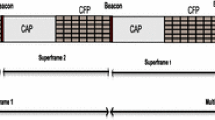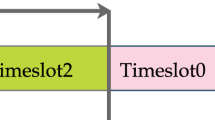Abstract
With the emerging popularity of the wireless local area network technology, many analytical models for its main medium access control mechanism, Distributed Coordination Function (DCF), have been reported. However, most of them are based on some oversimplifying assumptions, or need very complicated mathematical manipulations. In this paper, a simple and accurate packet delay model has been proposed for the IEEE 802.11 DCF mechanism in saturated traffic and error-prone industrial applications which is based on a modified discrete-time Markov chain model of the DCF mechanism which accounts for the backoff freezing. It estimates various delay parameters including the average, jitter, Cumulative Distribution Function, and the effect of Retry Limit. The simulation results confirm the accuracy of the proposed delay model compared with other similar models in the literature.












Similar content being viewed by others
References
IEEE. (2012). IEEE. Std 802.11-2012, IEEE Standard for Information technology-Telecommunications and information exchange between systems-Local and metropolitan area networks-specific requirements part 11: Wireless LAN Medium Access Control (MAC) and Physical Layer (PHY) Specifications. (Revision of IEEE Std 802.11-2007): IEEE.
Bianchi, G. (2000). Performance analysis of the IEEE 802.11 distributed coordination function. IEEE Journal on Selected Areas in Communications, 18(3), 535–547.
Bianchi, G., & Tinnirello, I. (2005). Remarks on IEEE 802.11 DCF performance analysis. IEEE Communications Letters, 9(8), 765–767.
Chatzimisios, P., Boucouvalas, A. C., & Vitsas, V. (2005). Performance analysis of the IEEE 802.11 MAC protocol for wireless LANs. International Journal of Communication Systems, 18(6), 545–569. doi:10.1002/dac.717.
Cena, G., Bertolotti, I. C., Valenzano, A., & Zunino, C. (2007). Evaluation of response times in industrial WLANs. IEEE Transactions on Industrial Informatics, 3(3), 191–201.
Willig, A. (2008). Recent and emerging topics in wireless industrial communications: A selection. IEEE Transactions on Industrial Informatics, 4(2), 102–124.
Raptis, P., Vitsas, V., & Paparrizos, K. (2009). Packet delay metrics for IEEE 802.11 distributed coordination function. Mobile Networks and Applications, 14(6), 772–781. doi:10.1007/s11036-008-0124-7.
Tinnirello, I., Bianchi, G., & Xiao, Y. (2010). Refinements on IEEE 802.11 distributed coordination function modeling approaches. IEEE Transactions on Vehicular Technology, 59(3), 1055–1067.
Felemban, E., & Ekici, E. (2011). Single hop IEEE 802.11 DCF analysis revisited: Accurate modeling of channel access delay and throughput for saturated and unsaturated traffic cases. IEEE Transactions on Wireless Communications, 10(10), 3256–3266.
Zhao, Q., Tsang, D. H. K., & Sakurai, T. (2011). Modeling nonsaturated IEEE 802.11 DCF networks utilizing an arbitrary buffer size. IEEE Transactions on Mobile Computing, 10(9), 1248–1263.
Dai, L., & Sun, X. (2012). A unified analysis of IEEE 802.11 DCF networks: Stability, throughput and delay. IEEE Transactions on Mobile Computing, Early, Access, 12(8), 1558–1572.
Fu, J., Zhou, Z., Zheng, L., & Liu, Z. (2012). Modeling the IEEE 802.11 DCF with hidden stations. Springer Advances in Intelligent and Soft Computing, 143, 855–860.
Tadayon, N., Askari, E., Aïssa, S., & Khabazian, M. (2012). A novel analytical model for service delay in IEEE 802.11 networks. IEEE Systems Journal, 6(4), 627–634.
Tian, G., & Tian, Y.-C. (2012). Modelling and performance evaluation of the IEEE 802.11 DCF for real-time control. Computer Networks, 56(1), 435–447. doi:10.1016/j.comnet.2011.10.001.
Maadani, M., & Motamedi, S. A. (2013). A simple and closed-form access delay model for reliable IEEE 802.11-based wireless industrial networks. Wireless Personal Communications, pp. 1–26. doi:10.1007/s11277-013-1465-5.
Li, Y., Wang, C., Long, K., & Zhao, W. (2008). Modeling channel access delay and Jitter of IEEE 802.11 DCF. Wireless Personal Communications, 47(3), 417–440. doi:10.1007/s11277-008-9491-4.
Keene, S. M., & Carruthers, J. B. (2012). Collision localization for IEEE 802.11 wireless LANs. Wireless Personal Communications, 63(1), 45–63.
Hasan, S. F., Siddique, N. H., & Chakraborty, S. (2013). Developments and constraints in 802.11-based roadside-to-vehicle communications. Wireless Personal Communications, 69(4), 1261–1287.
Pack, S., Kim, K., Kim, W., Song, T., & Min, S. (2013). A cross-layer approach to reduce channel access delay jitter in IEEE 802.11 WLANs. Wireless Personal Communications, 69(4), 1379–1390.
Ao, X., Jiang, S., & Yuan, H. (2013). Traffic-aware link rate adaptation for multi-rate 802.11 networks. Wireless Personal Communications, 72(4), 2155–2175.
Tinnirello, I., & Bianchi, G. (2010). Rethinking the IEEE 802.11 e EDCA performance modeling methodology. IEEE/ACM Transactions on Networking, 18(2), 540–553.
Gas, M., Kosek-Szott, K., Natkaniec, M., & Pach, A. R. (2011). 3D Markov chain-based saturation throughput model of IEEE 802.11 EDCA. Electronics Letters, 47(14), 826–827. doi:10.1049/el.2011.0693.2011.0693.
Maadani, M., & Motamedi, S. A. (2011). EDCA delay analysis of spatial diversity in IEEE 802.11-based real-time wireless sensor and actuator networks. In Wireless communication systems (ISWCS), 2011 8th international symposium on, 2011 (pp. 675–679): IEEE.
Maadani, M., Motamedi, S. A., & Safdarkhani, H. (2011). Delay-reliability trade-off in MIMO-enabled IEEE 802.11-based wireless sensor and actuator networks. Procedia Computer Science, 5, 945–950. doi:10.1016/j.procs.2011.07.133.
Hu, J., Min, G., Jia, W., & Woodward, M. E. (2012). Comprehensive QoS analysis of enhanced distributed channel access in wireless local area networks. Information Sciences, 214, 20–34. doi:10.1016/j.ins.2012.05.013.
Maadani, M., Motamedi, S. A., & Soltani, M. (2012). EDCA delay analysis of spatial multiplexing in IEEE 802.11-based wireless sensor and actuator networks. International Journal of Information and Electronics Engineering, 2(3), 318–322.
Cena, G., Seno, L., Valenzano, A., & Zunino, C. (2010). On the performance of IEEE 802.11 e wireless infrastructures for soft-real-time industrial applications. IEEE Transactions on Industrial Informatics, 6(3), 425–437.
Chatzimisios, P., Boucouvalas, A. C., & Vitsas, V. (2003). Influence of channel BER on IEEE 802.11 DCF. Electronics Letters, 39(23), 1687–1689. doi:10.1049/el:20031081.
Chatzimisios, P., Boucouvalas, A. C., & Vitsas, V. (2003). Packet delay analysis of IEEE 802.11 MAC protocol. Electronics Letters, 39(18), 1358–1359. doi:10.1049/el:20030868.
Vukovic, I. N., & Smavatkul, N. (2004). Delay analysis of different backoff algorithms in IEEE 802.11. In Vehicular technology conference, 2004. VTC2004-Fall. 2004 IEEE 60th, 2004 (Vol. 6, pp. 4553–4557): IEEE.
Wang, C., Lo, H.-K., & Fang, S.-H. (2011). Fairness analysis of throughput and delay in WLAN environments with channel diversities. EURASIP Journal on Wireless Communications and Networking, 42(1), 1–14.
Sakurai, T., & Vu, H. L. (2007). MAC access delay of IEEE 802.11 DCF. IEEE Transactions on Wireless Communications, 6(5), 1702–1710.
Chatzimisios, P., & Vitsas, V. (2007). Achieving performance enhancement in IEEE 802.11 WLANs by using the DIDD backoff mechanism. International Journal of Communication Systems, 20(1), 23–41. doi:10.1002/dac.811.
Author information
Authors and Affiliations
Corresponding author
Rights and permissions
About this article
Cite this article
Maadani, M., Motamedi, S.A. A Simple and Comprehensive Saturation Packet Delay Model for Wireless Industrial Networks. Wireless Pers Commun 77, 365–381 (2014). https://doi.org/10.1007/s11277-013-1510-4
Published:
Issue Date:
DOI: https://doi.org/10.1007/s11277-013-1510-4




